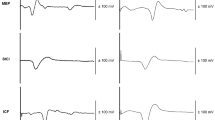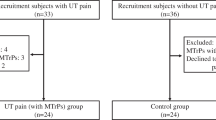Abstract
In orthopaedic shoulder instability, muscle activity (EMG) is altered during unconstrained discrete arm movement tasks (e.g. elevation against a load). These findings have been ascribed to deficits in afferent feedback and neural control with glenohumeral instabilities resulting from orthopaedic injury. However, the integrity of neural control during shoulder movements in those with unstable shoulders is unclear. It is not known if there are altered EMG patterns during rhythmic arm movement or during discrete tasks involving no load, as would be experienced in many arm motions performed in daily living. The primary objective of this study was to evaluate neural control of arm movements between those with unstable shoulders and control participants, within a constrained arm movement paradigm involving both rhythmic arm cycling and discrete reaching. To achieve this objective, we determined if the amplitude and timing of EMG related to the movement pattern (background EMG) was significantly different between groups. Cutaneous reflexes were used to simulate a perturbation to the upper limb that would typically evoke a coordinated response. In the elevation phase of the movement path for anterior and posterior deltoid, upper trapezius, infraspinatus and serratus anterior, background EMG during rhythmic arm cycling was significantly (24%, p < 0.05) larger in unstable shoulders than in controls. No differences were found in background EMG between the groups during the discrete task. Significant differences (p < 0.05) were also noted in cutaneous reflexes between groups for both the rhythmic and discrete tasks with the reflex amplitudes being either increased or reduced in unstable shoulders as compared to controls. The differences in the background EMG and the cutaneous reflexes patterns in those with shoulder instabilities suggest that neural control is altered during rhythmic movement.






Similar content being viewed by others
References
Adamovich SV, Levin MF, Feldman AG (1994) Merging different motor patterns: coordination between rhythmical and discrete single-joint movements. Exp Brain Res 99:325–337
Aydin T, Yildiz Y, Yanmis I, Yildiz C, Kalyon TA (2001) Shoulder proprioception: a comparison between the shoulder joint in healthy and surgically repaired shoulders. Arch OrthopTrauma Surg 121:422–425
Bastiaanse CM, Duysens J, Dietz V (2000) Modulation of cutaneous reflexes by load receptor input during human walking. Exp Brain Res 135:189–198
Blasier RB, Carpenter JE, Huston LJ (1994) Shoulder proprioception. Effect of joint laxity, joint position, and direction of motion. Orthop Rev 23:45–50
Brooke JD, McIlroy WE, Miklic M, Staines WR, Misiaszek JE, Peritore G, Angerilli P (1997) Modulation of H reflexes in human tibialis anterior muscle with passive movement. Brain Res 766:236–239
Brooke JD, Zehr EP (2006) Limits to fast-conducting somatosensory feedback in movement control. Exerc Sport Sci Rev 34(1):22–8
Burke R (1999) The use of state-dependent modulation of spinal reflexes as a tool to investigate the organization of spinal interneurons. Exp Brain Res 128(3):263–277
Christensen LOD, Morita H, Petersen N, Nielsen J (1999) Evidence suggesting that a transcortical reflex pathway contributes to cutaneous reflexes in the tibialis anterior muscle walking in man. Exp Brain Res 124:59–68
Danion F, Bonnard M, Pailhous J (1995) Joint-dependent mechanisms to adapt to an imbalance between flexion and extension forces in human gait. Neurosci Lett 187:185–188
Danion F, Bonnard M, Pailhous J (1997) Intentional on-line control of propulsive forces in human gait. Exp Brain Res 116:525–538
Dietz V (1992) Human neuronal control of automatic functional movements: interaction between central programs and afferent input. Physiol Rev 72:33–69
Donker SF, Mulder Th, Nienhuis B, Duysens J (2002) Adaptations in arm movements for added mass to wrist or ankle during walking. Exp Brain Res 145:26–31
Forwell LA, Carnahan H (1996) Proprioception during manual aiming in individuals with shoulder instability and controls. J Orthop Sports Phys Ther 23:111–119
Glousman R, Jobe F, Tibone J, Moynes D, Antonelli D, Perry J (1988) Dynamic electromyographic analysis of the throwing shoulder with glenohumeral instability. J Bone Joint Surg Am 70:220–226
Hundza SR, Zehr EP (2006) Cutaneous reflexes during rhythmic arm cycling are insensitive to asymmetrical changes in crank length. Exp Brain Res 168:165–177
Jerosch J, Steinbeck J, Schroder M, Westhues M, Reer R (1997) Intraoperative EMG response of the musculature after stimulation of the glenohumeral joint capsule. Acta Orthop Belg 63:8–14
Kronberg M, Brostrom LA, Nemeth G (1991) Differences in shoulder muscle activity between patients with generalized joint laxity and normal controls. Clin Orthop Relat Res 269:181–192
Kronberg M, Nemeth G, Brostrom LA (1990) Muscle activity and coordination in the normal shoulder. An electromyographic study. Clin Orthop Relat Res 257:76–85
Lephart S, Warner JJ, Borsa PA, Fu FH (1994) Proprioception of the shoulder joint in healthy, unstable, and surgically repaired shoulders. J Shoulder Elbow Surg 3:371–380
Lephart SM, Pincivero DM, Giraldo JL, Fu FH (1997) The role of proprioception in the management and rehabilitation of athletic injuries. Am J Sports Med 25:130–137
Matsen FA, Harryman DT, Sidles JA (1991) Mechanics of Glenohumeral Instability. Clin Sports Med Oct 10(4):783–8
McMahon PJ, Jobe FW, Pink MM, Brault JR, Perry J (1996) Comparative electromyographic analysis of shoulder muscles during planar motions: anterior glenohumeral instability versus normal. J Shoulder Elbow Surg 5:118–123
Morris AD, Kemp GJ, Frostick SP (2004) Shoulder electromyography in multidirectional instability. J Shoulder Elbow Surg 13:24–29
Myers JB, Ju YY, Hwang JH, McMahon PJ, Rodosky MW, Lephart SM (2004) Reflexive muscle activation alterations in shoulders with anterior glenohumeral instability. Am J Sports Med 32:1013–1021
Myers JB, Lephart SM (2002) Sensorimotor deficits contributing to glenohumeral instability. Clin Orthop Relat Res 400:98–104
Ohta K, Sivinin MM, Luo ZW, Hosoe S, Laboissiere R (2004) Optimal trajectory formation in constrained human arm reaching movements. Biol Cybern 91(1): 23–36
Reid DC (1992) Shoulder region. In: Burgess L, Terry D (eds) Sports injury assessment and rehabilitation. Churchill Livingston Inc., pp 895–998
Rossignol S (1996) Neural control of stereotypic limb movements. In: Rowell LB, Shepherd JT (eds) Section 12. Exercise: Regulation and integration of multiple systems. Oxford University Press, pp 173–216
Schaal S, Sternad D, Osu R, Kawato M (2004) Rhythmic arm movement is not discrete. Nat Neurosci 7:1136–1143
Smith RL, Brunolli J (1989) Shoulder kinesthesia after anterior glenohumeral joint dislocation. Phys Ther 69:106–112
Smits-Engelsman BC, Swinnen SP, Duysens J (2006) The advantage of cyclic over discrete movements remains evident following changes in load and amplitude. Neurosci Lett 96(1):28–32
Smits-Engelsman BC Van Galen GP, Duysens J (2002) The breakdown of Fitts’ law in rapid, reciprocal aiming movements. Exp Brain Res 145:222–230
Tibone JE, Fechter J, Kao JT (1997) Evaluation of a proprioception pathway in patients with stable and unstable shoulders with somatosensory cortical evoked potentials. J Shoulder Elbow Surg 6:440–443
VanWezel BMH, Ottenhoff FAM, Duysens J (1997) Dynamic control of location-specific information in tactile cutaneous reflexes from the foot during human walking. J Neurosci 17:3804–3814
Wallace DA, Beard DJ, Gill RH, Eng B, Carr AJ (1997) Reflex muscle contraction in anterior shoulder instability. J Shoulder Elbow Surg 6:150–155
Wei KL, Wertman G, Sternad D (2003) Interactions between rhythmic and discrete components in a bimanual task. Motor Control 7:134–154
Wilk KE, Arrigo CA, Andrews JR (1997) Current concepts: the stabilizing structures of the glenohumeral joint. J Orthop Sports Phys Ther 25:364–379
Zehr EP (2005) Neural control of rhythmic human movement: the common core hypothesis. Exerc Sport Sci Rev 33(1):54–60
Zehr EP, Carroll TJ, Chua R, Collins DF, Frigon A, Haridas C, Hundza SR, Kido A (2004) Possible contributions of spinal CPG activity to rhythmic human arm movement. Can J Physiol Pharmacol 82:556–568
Zehr EP, Chua R (2000) Modulation of human cutaneous reflexes during rhythmic cyclical arm movement. Exp. Brain Res 135:241–250
Zehr EP, Duysens J (2004) Regulation of arm and leg movement during locomotion. Neuroscientist 10(4):347–361
Zehr EP, Hundza SR (2005) Forward and backward arm cycling are regulated by equivalent neural mechanisms. J Neurophysiol 93(1):633–640
Zehr EP, Kido A (2001) Neural control of rhythmic, cyclical human arm movement: task dependency, nerve specificity and phase modulation of cutaneous reflexes. J Physiol (Lond) 537:1033–1045
Zehr EP, Koniyama T, Stein RB (1997) Cutaneous reflexes during human gait: electromyographic and kinematic responses to electrical stimulation. J Neurophysiol 77:3311–3325
Acknowledgments
This work was supported by grants to EPZ from the Natural Sciences and Engineering Council of Canada (NSERC), the Heart and Stroke Foundation of Canada (BC and Yukon), the Michael Smith Foundation for Health Research. SRH was supported by the Focus on Stroke (Heart and Stroke Foundation of Canada (BC and Yukon), Canadian Institute of Health Research (CIHR) and Canadian Stroke Network, AstraZeneca) and the Michael Smith Foundation for Health Research. We would also like to thank C. Landells MD, FRCP and Z. Zazour MD, FRCP for their assistance with participant recruitment.
Author information
Authors and Affiliations
Corresponding author
Rights and permissions
About this article
Cite this article
Hundza, S.R., Zehr, E.P. Muscle activation and cutaneous reflex modulation during rhythmic and discrete arm tasks in orthopaedic shoulder instability. Exp Brain Res 179, 339–351 (2007). https://doi.org/10.1007/s00221-006-0793-z
Received:
Accepted:
Published:
Issue Date:
DOI: https://doi.org/10.1007/s00221-006-0793-z




